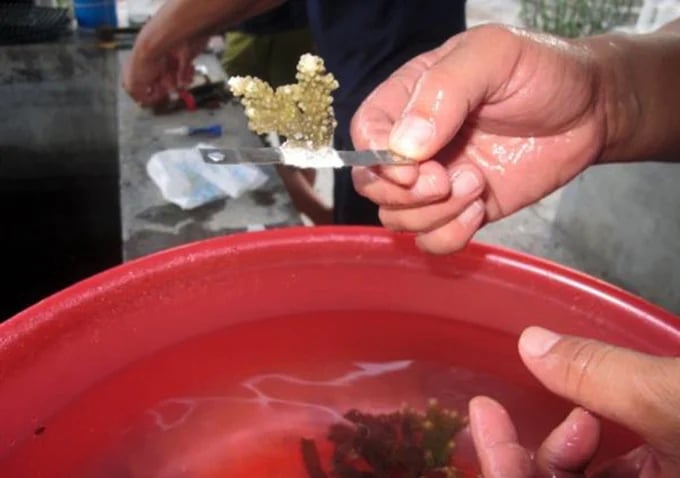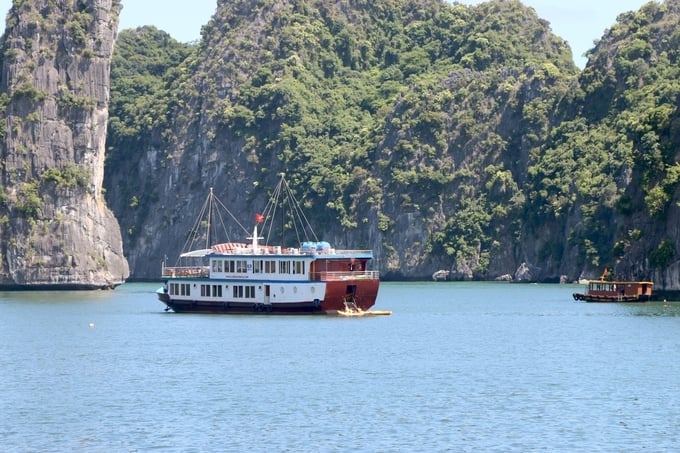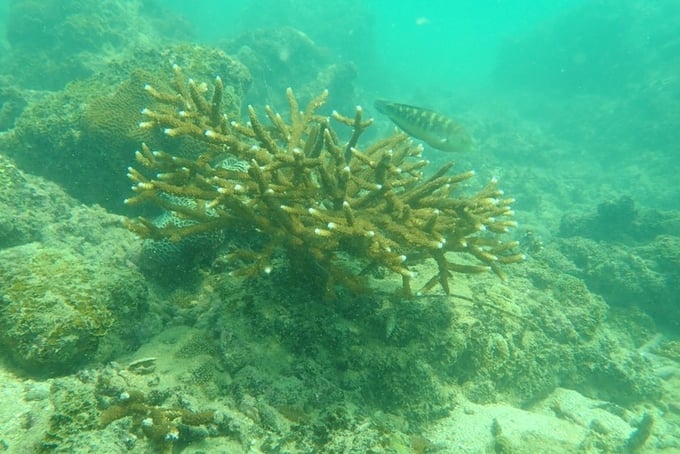November 26, 2025 | 13:20 GMT +7
November 26, 2025 | 13:20 GMT +7
Hotline: 0913.378.918
November 26, 2025 | 13:20 GMT +7
Hotline: 0913.378.918

The coral reefs within the Cat Ba Hai Phong tourist area embody the essence of the Gulf of Tonkin waters. Photo: RIMF.
Coral reefs are acknowledged as unique ecosystems in tropical waters, holding significant biodiversity value. They serve as habitats, providing sustenance for marine flora and fauna while playing a pivotal role in sustaining and enhancing marine resources. Attracting diverse marine species, coral reefs are recognized as one of the world's most productive ecosystems.
The ecosystem's value lies in its contribution of material and energy to water bodies, provision of habitats for marine life, supply of high-value aquatic resources, the establishment of breeding grounds and nurseries for aquatic life, coastal protection, and the creation of scenic landscapes for tourism and recreation.
As such, the coral reef ecosystem significantly influences natural conditions, aquatic resources, socio-economic development, and tourism for local communities and coastal regions.
According to the Research Institute for Marine Fisheries, scientists in Cat Ba have identified approximately 193 coral species, with 166 belonging to hard corals. The remaining 27 are distributed among creeping, soft, and horn-shaped corals.
The coral reefs around Cat Ba Island exhibit an atypical coastal reef structure, categorized into three sub-types: closed, semi-closed, and open. The estimated total reef area is around 85 hectares, with coral reefs dispersed in small, narrow formations.
Although the coral reefs in the Cat Ba archipelago may not rival the size and splendor of those in the southern seas, they represent the Gulf of Tonkin's most stunning coral reefs. This area serves as a crucial hub for the dispersal of genetic resources in the Gulf of Tonkin, contributing significantly to conservation efforts and offering a unique diving experience to witness the beauty of coral.

Coral reefs hold immense value for conservation efforts and tourism development, particularly through the unique experience of coral diving. Photo: Dinh Muoi.
Several years ago, surveys indicated that the seawater quality in the coral reef ecosystem around Cat Ba Island displayed signs of local pollution, with certain parameters exceeding the quality standards proposed by ASEAN. In some areas, the coverage was as low as 41%. Recognizing this issue, the Research Institute for Marine Fisheries undertook extensive research and successfully implemented coral planting and restoration initiatives in Cat Ba National Park. Simultaneously, they employed the small fragment separation method to restore hard corals in the Bach Long Vi Marine Protected Area (MPA), achieving remarkable efficiency.
Collaborating with Cat Ba National Park, the Research Institute for Marine Fisheries identified coordinates to delineate protection zones for 12 key coral reefs along the Cat Ba National Park coastline. Additionally, they established a system of 40 mooring buoys to safeguard coral reefs in five priority areas. This buoy system undergoes regular maintenance to ensure optimal operation in field conditions.
Experts and researchers restored 3,400 square meters of coral reefs, encompassing 3,879 coral colonies across four locations. Over a span of 36 months, the average survival rate reached an impressive 58.97%, with an average growth rate of 5.58mm per month.
The restored coral exhibits robust growth and adaptation to various weather conditions throughout the year, including dry and rainy seasons. Furthermore, experts successfully rejuvenated a group of coral branches on four reefs that had previously faced near-complete degradation.

Ongoing research into hard coral restoration at Bach Long Vi Island conservation area continues to employ the small fragment method. Photo: RIMF.
On Bach Long Vi Island, scientists have undertaken comprehensive research and surveys to assess the current state of coral reefs. They meticulously selected specific coral species for restoration efforts, conducting surveys to pinpoint areas requiring coral restoration, understand coral reef characteristics, and evaluate coral reef resources. Simultaneously, they organized research to assess the environmental conditions in marine areas slated for coral restoration.
In the practical implementation phase, scientists focused on constructing a coral breeding process within tanks, achieving a production scale of 1,000 coral colonies ranging from 1.5 to 3.5 cm. They researched harvesting techniques and transported natural and domesticated corals in controlled breeding conditions. Furthermore, scientists explored methods for separating coral seeds for nursery purposes.
Additionally, scientists dedicated efforts to researching and evaluating the viability of artificial corals in thriving within the natural environment. They refined and proposed a comprehensive process for planting and restoring corals using artificially produced seed sources in their natural habitat.
These efforts culminated in successfully producing artificial hard coral seeds in tanks at Bach Long Vi, boasting an impressive survival rate of 70%, with sizes ranging from 1.5 to 3.5 cm. The subsequent process of planting and restoring hard coral in the natural environment, utilizing these artificially produced seed sources, achieved a survival rate exceeding 70%.
This successful research has significantly contributed to marine conservation at Bach Long Vi, playing a crucial role in restoring and developing coral reefs. This contribution extends to enhancing biodiversity in the surrounding waters, rejuvenating aquatic resources around the island, and supplementing resources for Bach Long Vi's fishing grounds.
The Research Institute for Marine Fisheries underscores that the primary contributors to coral reef degradation are human activities, including overfishing, aquaculture, pollution from marine waste and seawater sweeteners, and impacts from tourism activities and tourist boats. Consequently, the institute advocates for measures beyond fishing bans, emphasizing the need for stable alternative income sources for those reliant on fisheries. Clear regulations specifying when and how areas can be exploited, permitted equipment, and minimum catch sizes are proposed to ensure sustainable practices and foster a comprehensive understanding among the local populace.
Translated by Quynh Chi

(VAN) The model of making a living under the forest canopy through the agroforestry system in Van Son commune, Bac Ninh province, is expected to generate an annual income of approximately VND 30 million/ha.

(VAN) Many enterprises in Can Tho are harnessing natural energy and reducing greenhouse gas emissions in their production processes, thereby contributing to the promotion of a sustainable green transition.
/2025/11/24/3536-2-112800_176.jpg)
(VAN) Dong Nai now has tens of thousands of hectares of forests certified for sustainable management, and this area will continue to be expanded in the coming period.

(VAN) Vinh Ha hamlet (Dai Xuyen commune, Hanoi) is shifting away from small-scale farming as households adopt bioscurity into their breeder chicken models.

(VAN) Heavy rains make aquatic species more vulnerable to disease. Proactive water management and high-tech systems help farmers prevent outbreaks and protect yields.

(VAN) Greenhouses are shifting production mindsets in Binh Lu commune, enabling farmers to ‘weather the sun and rain’ and secure stable vegetable harvests throughout the year.

(VAN) Green transition is crucial for the Mekong Delta amid climate change and stricter standards, offering a path toward sustainability.